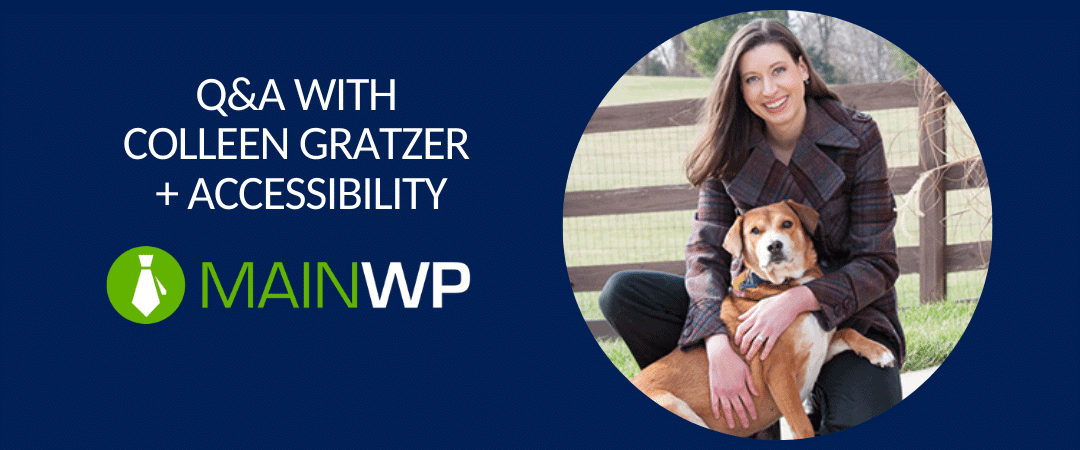Accessibility.
Two things to note. First, I have a hard time spelling it. What about you?
Second, I am woefully inadequate to talk about the topic.
Almost four years ago, I posted two articles on MainWP about accessibility.
In the conclusion of the second article, I wrote,
To make your website Accessibility-ready, you will still have to do your part. Remember, part of making a site Web Accessible is following best practices with your content which exist aside from your theme.
I think this remains true. I know very little more than I knew then.
So, this time I put on my journalist hat and reached out to a new connection, which is an expert. Her name is Colleen Gratzer, and she has been working in branding, design, and development for over 23 years.
Four years ago, she was trained by one of the top accessibility providers to the U.S. government. Now, Colleen is one of the go-to experts in the WordPress and website design space for accessibility.

Appearances include the who’s who in the WordPress space, including an accessibility webinar for WP Elevation and podcasts such as Smart Web Creators, Agency Trailblazer, Design for Geeks, Logo Geek, and Nailing It.
I reached out to her for an interview. She gave me so much valuable information that it is enough to fill up two articles, perhaps more.
So, today, in this article, we are going to let her tell us more about the evolution from designer to accessibility expert.
In the next article, she is going to give us some super value information on improving our accessibility skills.
Some of the things you will learn includes:
- The degree that got her started
- The early tools she worked with
- A massive website job she had early in her career
- Her first thoughts about WordPress and how it changed
- How she got started with accessibility
- The many reasons she thinks designers and developers don’t value accessibility
- Why there is no quick fix
How did you get started with website design?
I studied graphic design in college in the mid-90s, which was when websites were first being built. Web design was not part of the curriculum then.
I just so happened to have also taken a computer science class, where I learned Hypercard, which was very similar to FileMaker Pro, along with HTML. I picked up HTML very quickly. Because of that and my design background, my teacher asked me to switch my major to computer science. I didn’t.
Ironically, I didn’t finish my graphic design degree either. During those four years of college, I was also pursuing a degree in foreign languages (Spanish and French). I did finish that degree and had only a couple of consecutive classes left in the graphic design degree. But I had lined up a job as a designer to start right after graduation, so I earned the one degree and started my career as a designer.
The work I’ve done over my career has run the gamut—branding, print, publications, website, and emails. I’ve since narrowed the focus of the business, though.
I remember this one website, back in the early 2000s, where I took a 1,600-page website that was built in tables and redid all the code and reformatted the entire site using templates and nested templates. I was able to also fix a lot of page content issues as well. I did the bulk of it with a lot of search/replacing.
I remember this one website, back in the early 2000s, where I took a 1,600-page website that was built in tables and redid all the code and reformatted the entire site using templates and nested templates. Colleen Gratzer
Of course, since the advent of CMS platforms, you don’t have to do that anymore.
When WordPress came out, I hated it at first because it was so different from how I was used to building websites. I didn’t know any PHP (I still don’t), but I could look up some PHP code and copy and paste it where it should go. I am good at picking up on the patterns and syntax and figuring out what I should or shouldn’t mess with.
Over the past two years, though, I have had a developer. So I don’t need to mess with code anymore. I just advise on the accessibility, and I’m teaching him how to build accessible websites.

Recently, you have pivoted to work more with accessibility. When did you decide that accessibility was something you wanted to help others with?
It’s funny how I got started. A colleague who’s known of me for probably 20 years or so (we run in some of the same circles) reached out and asked if I’d be interested in taking her InDesign and PDF accessibility class. She is one of the top accessibility providers to the U.S. government and on one of the accessibility boards.
That was in 2016. I didn’t understand what accessibility even was, and I’d heard of her class but had never given it any thought. She thought it would be a good fit for my skills because of my strong design and coding background.
So I took the class. I learned a lot about the importance of accessibility and the laws, how many people have a disability, how someone with a disability needs to be able to get around a document, and so forth.
It was really shocking to me to learn how much accessibility is ignored or an afterthought.
Again, that was for accessibility with InDesign and PDF files. I picked it up quickly, especially because of my strong InDesign and HTML skills.
Now, I was still building websites too, and I wanted to apply what I had learned from that class to websites. I spent many months weeding through a lot of good (and bad) information, consulting with other accessibility experts, and refining my web design and development process over a long period of time.
Why do you think developers and designers don’t value accessibility more?
Value design over usability
Accessibility is an important topic. It’s really unbelievable that this has not been a bigger topic in the design world, especially because design is about communication.
But some designers value design over usability. (Remember the days of “This site is best viewed in Internet Explorer?”)
You shouldn’t make people have to change browsers to load a site, prevent them from being able to get around portions of a site or force them to use some other method to get around a site, which I’ll get into later.
If a website or document you create looks good but isn’t functional or readable to up to 20% of the audience, how is it considered to be successful?
You shouldn’t make people have to change browsers to load a site, prevent them from being able to get around portions of a site, or force them to use some other method to get around a site, which I’ll get into later. Colleen Gratzer
Don’t know about it or don’t understand it.
Most designers and developers don’t know about accessibility, or they’ve only heard of it because of the plethora of website accessibility lawsuits in the United States over the past three years.
Most people don’t think about accessibility unless they or someone they know has a disability. If it’s not part of their day-to-day life, they usually don’t understand the issues that many people face.

Assume it’s only for people with blindness or for a small population
I’ve found that a lot of designers and developers (and clients too) think that website accessibility is only for the blind. But visual disabilities comprise the smallest portion of all types of disabilities, and blindness is only a portion of those.
Some think that people with disabilities are in the minority, but 15% to 20% of the worldwide population is affected. We’re talking color blindness, macular degeneration, cataracts, hearing loss or deafness, a broken arm (because some disabilities are temporary in nature), a lost limb, arthritis, multiple sclerosis, dyslexia, dementia, cerebral palsy, stroke… There are others.
Assume it’s hard to do
Some may think that accessibility is hard to implement. That’s not necessarily the case. Some things are easier to address than others, especially if you’re relying on a third-party theme or plugin.
There’s a lot to check for too, but it’s not difficult if you integrate the proper steps into your workflow. When it’s an afterthought, though, it is more difficult and more costly.
For instance, the design might need to drastically change. You might have to redo part or all of a client’s color palette. You might have to change themes, which means you’ve got to carry over any custom fields into the new theme and so forth. You might have to go add missing Alt-text to images in the Media Library and in the images that are already on the page. The list goes on.
Some may think that accessibility is hard to implement. That’s not necessarily the case. Some things are easier to address than others, especially if you’re relying on a third-party theme or plugin. Colleen Gratzer

Assume their clients don’t serve anyone with a disability
I’ve heard from some designers and developers that they don’t build accessible websites because their clients don’t serve anyone with a disability. How does the client know that? They do not see every person who visits their website. They don’t know how that person is getting around their site, whether it’s via assistive technology, a keyboard, or a mouse—that is, if they are able to get around the site at all. If the site’s not accessible, someone might call to complain or they might file a legal complaint. But it’s highly likely they will go to a competitor’s site instead.
Assume it can easily be done later with an overlay or plugin
One of the scariest things I’ve heard is designers and developers thinking that if the client decides later, they need an accessible website; they’ll just add an overlay or plugin to make the site accessible. They think it will be a quick fix, so it’s no big deal.
Those things can’t even detect about 70% of issues, so they certainly can’t fix them either. Of some of the issues they actually can fix, they don’t or can’t fix them properly. The vendors of these overlays have them installed on their own websites, and they are full of accessibility issues!
Those overlays actually make a website less accessible and slow down the site. They also usually force someone to use their unique interface instead of what they’re used to using.
Could you imagine if you normally use a mouse to get around a website, then you go to a particular website and have to use only the keyboard or a screen reader or something else? Would you know how to do that? What if the site you’re on isn’t set up properly for that, so you can no longer get around the site?
Could you imagine if you normally use a mouse to get around a website, then you go to a particular website and have to use only the keyboard or a screen reader or something else? Colleen Gratzer
There is no magic bullet, no quick fix. It starts with the proper code.
Wrapping it up
Colleen helps other freelance designers and developers with issues like accessibility with community Creative Boost. The website includes resources, a podcast, articles, mentoring and coaching, and much more.
Her main business is Grazer Graphics, where she helps nonprofits with branding and accessibility. Gratzer also has an accessibility course, Foundations of Website Accessibility.
For designers learning more, they can download her free guide Understanding and Selling Accessible Websites.







